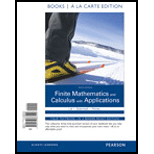
Concept explainers
Minority Population According to the U.S. Census Bureau, the United States is becoming more diverse. Based on U.S. Census population projections for 2000 to 2050, the projected Hispanic population (in millions) can be modeled by the exponential function
h(t) = 37.79(1.021)t,
where t = 0 corresponds to 2000 and 0 < t < 50. Source: U.S. Census Bureau.
(a) Find the projected Hispanic population for 2005. Compare this to the actual value of 42.69 million.
(b) The U.S. Asian population is also growing exponentially, and the projected Asian population (in millions) can be modeled by the exponential function
a(t) = 11.14(1.023)t,
where t = 0 corresponds to 2000 and 0 < t < 50. Find the projected Asian population for 2005, and compare this to the actual value of 12.69 million.
(c) Determine the expected annual percentage increase for Hispanics and for Asians. Which minority population, Hispanic or Asian, is growing at a faster rate?
(d) The U.S. black population is growing at a linear rate, and the projected black population (in millions) can be modeled by the linear function
b(t) = 0.5116t + 35.43,
where t = 0 corresponds to 2000 and 0 < t < 50. Find the projected black population for 2005 and compare this projection to the actual value of 37.91 million.
(e) Graph the projected population function for Hispanics and estimate when the Hispanic population will be double its actual value for 2005. Then do the same for the Asian and black populations. Comment on the accuracy of these numbers.
Want to see the full answer?
Check out a sample textbook solution
Chapter 10 Solutions
Finite Mathematics and Calculus with Applications Books a la Carte Plus MyLab Math Package (10th Edition)
- Enter the data from Table 2 into a graphing calculator and graph the ranking scatter plot. Determine whetherthe data from the table would likely represent a function that is linear, exponential, or logarithmic.arrow_forwardExplain why the values of an increasing exponentialfunction will eventually overtake the valuesof anincreasing linear function.arrow_forwardDoes a linear, exponential, or logarithmic model best fit the data in Table 2? Find the model.arrow_forward
- What might a scatterplot of data points look like if it were best described by a logarithmic model?arrow_forwardWith what kind of exponential model would half-life be associated? What role does half-life play in these models?arrow_forwardFind an exponential equation that passes throughthe points (0,4) and (2,9).arrow_forward
- Table 6 shows the year and the number ofpeople unemployed in a particular city for several years. Determine whether the trend appears linear. If so, and assuming the trend continues, in what year will the number of unemployed reach 5 people?arrow_forwardMaria, a biologist is observing the growth pattern of a virus. She starts with 100 of the virus that grows at a rate of 10% per hour. She will check on the virus in 24 hours. How many viruses will she find?arrow_forwardWith what kind of exponential model would doubling time be associated? What role does doubling time play in these models?arrow_forward
 Glencoe Algebra 1, Student Edition, 9780079039897...AlgebraISBN:9780079039897Author:CarterPublisher:McGraw Hill
Glencoe Algebra 1, Student Edition, 9780079039897...AlgebraISBN:9780079039897Author:CarterPublisher:McGraw Hill College Algebra (MindTap Course List)AlgebraISBN:9781305652231Author:R. David Gustafson, Jeff HughesPublisher:Cengage Learning
College Algebra (MindTap Course List)AlgebraISBN:9781305652231Author:R. David Gustafson, Jeff HughesPublisher:Cengage Learning
 Big Ideas Math A Bridge To Success Algebra 1: Stu...AlgebraISBN:9781680331141Author:HOUGHTON MIFFLIN HARCOURTPublisher:Houghton Mifflin HarcourtAlgebra & Trigonometry with Analytic GeometryAlgebraISBN:9781133382119Author:SwokowskiPublisher:Cengage
Big Ideas Math A Bridge To Success Algebra 1: Stu...AlgebraISBN:9781680331141Author:HOUGHTON MIFFLIN HARCOURTPublisher:Houghton Mifflin HarcourtAlgebra & Trigonometry with Analytic GeometryAlgebraISBN:9781133382119Author:SwokowskiPublisher:Cengage





